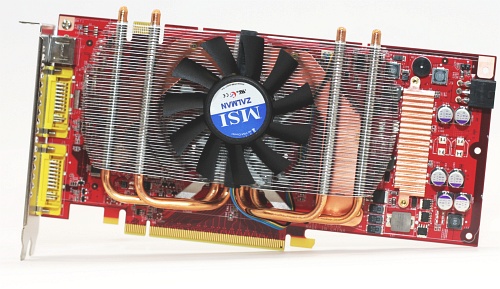

Review: Up to 15 percent better
MSI is working hard lately in order to deliver innovative products. All of these are “green” and MSI plans to emphasize “ECOlution” (Eco-friendly and environmental evolution) at this year’s CeBIT. Conserving energy and protecting the environment are the best way to draw buyers'’ attention, and since we all know that humans and nature are interdependent, it’s us, the end users that should take control. By purchasing clean and power-conserving devices we protect ourselves.
Today we have a Geforce 9600 GT card with a cooler that mimics nature. Well, it might be a bit too much to compare a simple cooler to such a complex system, but MSI claims that they’ve been observing seaweed when they were looking for new and innovative solutions. At that point they got some ideas and this new cooler has slightly bent fins that enable for better airflow regulation. So, MSI’s new cooler design has a bit of each - nature’s genius and MSI’s advanced technology. Thus, the Seaweed-Blade cooler was born, and it does a great job cooling the GPU better using less RPM, and it runs quietly at the same time.

This MSI’s cooler should replace Zalman’s coolers on Zilent cards. We tested one of those and you can find the review here.

Zilent (Zalman) cooler’s heatpipes were quite large and it got in the way of SLI connectors. The new cooler has shorter heatpipes and if you choose these cards for your SLI setup you definitely won’t be sorry. Both coolers are quiet and they’ll do a good job cooling the card.

The card’s full name is N9600GT - T2D512 – OC, and the name implies that the card is overclocked.

You can see that Seaweed-Blade cooler is placed in the center and is hugged by the heatsink. That enables for side-cooling and it results in much better heat dissipation. Memory doesn’t have any heatspreaders on it and it’s cooled by the air from the cooler. The memory in question is Samsung K4J52324QE-BJ1A, and it’s the same one that’s featured on reference cards, but MSI overclocked it from 900 to 975MHz. Eight memory modules make up a total of 512MB of GDDR3 memory. Memory interface is 256-bit, and it’ll definitely come in handy in a time when games are increasingly demanding.

The card’s PCB is reference but painted red. Nvidia most certainly won’t like this, but it simply looks better combined with the red cooler. Two dual-link DVI outs are blue for a change, whereas 8800 GT features standard yellow DVI connectors.
HDMI is easy with 9600 GT and you’ll get a DVI-to-HDMI dongle in the box. In order to have sound through HDMI, you’ll need to use a S/PDIF cable and connect it to a S/PDIF out on your motherboard or soundcard. A white pinhead connector located left of the SLI connector on the graphics card is the place where you plug in the S/PDIF cable.

You might agree that this cooler has a futuristic design and it somewhat resembles high-speed powerboats. The rear part, on the other hand, looks more like a trunk, and it’s used to route and enable for hot air outtake through bracket fins. Due to the cooler this card is dual-slot.

Aluminum heatsink is quite small and light. The fins, base and heatpipes are all made of aluminum and the fan stays fastened to the red hood even when you take the heatsink off.

MSI opted for quiet YS Tech YD128015HL DC 12V fan. We heard that newer versions of D.O.T. or Dual Core Center tools should render this card totally silent. That means that the fan won't start until GPU temperatures hit 82°C. (Updated: Only with Hybrid fan design - for now it is available on the 8800GT cards)
We tried to install these tools, but current versions don't offer this; we couldn't even regulate fan speed. For some strange reason, at one point we even heard it at maximum RPM, but during testing it was inaudible and kept temperatures under 62°C. Idle temperature was around 39°C.
There will be new versions of D.O.T. interface aimed at Europe and USA, and it'll be similar to AMD's Overdrive tool. That'll make it possible to control and overclock the card using just one app.
The card’s core runs at 730MHz with Shader Processor speeds of 1825MHz. MSI did a good job with core and Shader overclocks, but when it comes to memory – we were a bit disappointed. Most of the partners that decided to overclock 9800GT’s, overclocked the memory to 1000MHz. Nevertheless, this card is still faster than many on the market and MSI’s cooler is the icing on the cake.
Using D.O.T. tool and “Gaming” overclocking option we’ve seen automatic core speed increase to 966MHz and shader speed boost to 1916MHz. Memory refused to budge and stayed at 975MHz.

Two U-shaped heatpipes equally spread the heat on both sides. You’ll notice that the design is quite nice and the heatsink goes through aluminum fins twice. It’s fixed on the base and in direct contact with the fins.

The entire cooler is easy to mount and all you need to do is screw four bolts on the back of the card.
We’ve seen that MSI has another 9600 GT card using a new cooler, and we’re talking about a 1GB memory card called N9600GT-T2D1G. We were quite happy with this 512MB version, and we'll leave 1GB versions to those who have a clear idea of where to use it.

The new cooler design is a good step forward. People have often looked to nature for answers, and it usually turned out to be a good idea.
MSI will also showcase their first anion-producing notebook at CeBIT. This notebook will be the first in MSI's "Green Design“ series and will release a high concentration of anions, air purifying particles. Hey, who needs a break for fresh air in an office filled with these babies?
